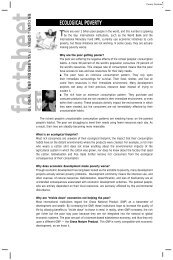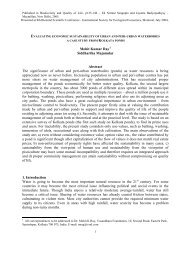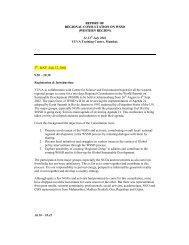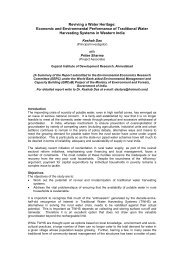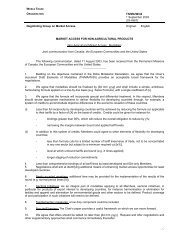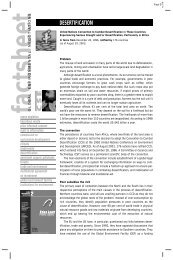Technical details - Rainwater Harvesting
Technical details - Rainwater Harvesting
Technical details - Rainwater Harvesting
Create successful ePaper yourself
Turn your PDF publications into a flip-book with our unique Google optimized e-Paper software.
Design Tips<br />
Design your roof well for rainwater collection<br />
A flat roof can be gently sloped to drain water towards the storage system. A 'nahani trap' or 'floor trap' can<br />
be placed at the time of casting the roof just near the inlets of the down water pipes<br />
Sloping roofs should have a gutter of PVC or zinc sheet to collect water & channel it to the down water pipe<br />
system.<br />
Roofs should be uncluttered & should be easy to clean by sweeping & swabbing if necessary.<br />
Down water pipes should be designed well<br />
90mm dia. PVC pipes resistant to UV rays appear to be the best bet as downwater pipes. Of course, this<br />
depends upon the roof area to be drained.<br />
3 to 4 downwater pipes seem sufficient for 1000 to 1200 sft area<br />
Filter the rainwater before storage<br />
Filtering can be as basic as a floor trap placed before the water enters the downwater pipe or a piece of<br />
sponge placed at the inlet of the downwater pipe<br />
• a PVC bucket with gravel, sand & charcoal is a good filter before rainwater is stored<br />
• a PVC drum with sponge at the inlet & outlet is also a filter<br />
• a small two chamber inspection/ filter tank can also be devised<br />
Try to determine your storage system at the planning stage itself.<br />
Would it be a:<br />
• Roof level storage tank<br />
• Ground level drum or masonry tank<br />
• Below the ground sump<br />
• Partially below ground and partially above ground tank<br />
Locate the storage system properly<br />
• Roof level storage tanks may need to be at the rear of the house or on the sides so that it is neither<br />
obtrusive nor visually offensive.<br />
• Ground level drums or tanks occupy space and should not hinder movement or appear unsightly.<br />
• Below the ground sump is a good option since most new constructions in Bangalore go in for sumps<br />
anyway. Sumps are hidden from view, less costly to build and do not obstruct movement.<br />
Note: always provide for an outlet for excess collection of water from the storage system<br />
Further treatment of excess rainwater<br />
It is a common perception that water stored for long goes bad. If water does not contain any organic material<br />
and if it is stored in a clean container it can stay for a long time.<br />
Some small treatment like ‘alum dosing’ or ‘chlorination’ can also be done to stored water to improve its<br />
quality.<br />
Addition of a small quantity of alum dissolved in half a bucket of water will bring down the suspended solids<br />
and clear the stored rainwater.<br />
<strong>Technical</strong> Details of <strong>Rainwater</strong> <strong>Harvesting</strong> 6




